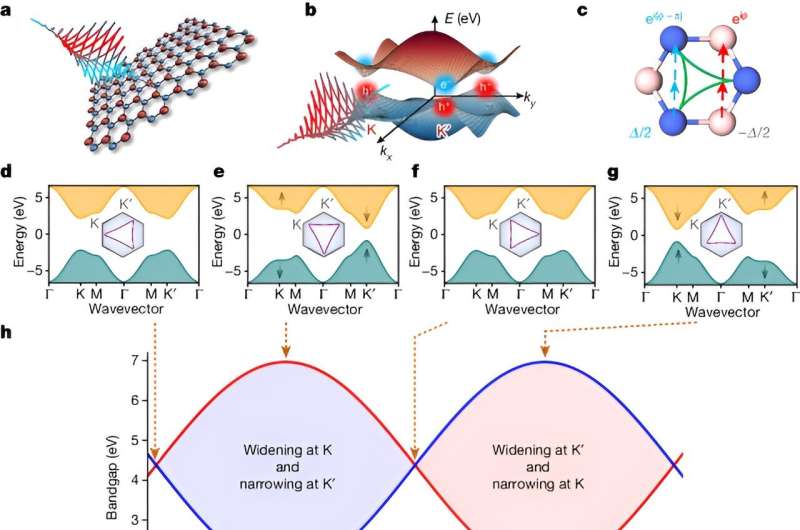Lightwave-controlled valley-selective bandgap modification. Credit: nature (2024). DOI: 10.1038/s41586-024-07244-z
A group of scientists has developed a method that uses the structure of light to twist and tune the properties of quantum materials.Their results were published today in naturepaving the way for next-generation advancements in quantum electronics, quantum computing and information technology.
The team, led by researchers from the Department of Energy’s SLAC National Accelerator Laboratory and Stanford University, applied this approach to a material called hexagonal boron nitride (hBN), which is formed in a honeycomb pattern. A single layer of aligned atoms with unique properties suitable for quantum manipulation. In their experiments, the scientists used a special type of light with an electric field that looks like a clover to change and control the material’s behavior at the quantum level at ultrafast timescales.
The way light waves twist also allows researchers to precisely control the rules of the material’s quantum properties, which determine how electrons behave, which is crucial for electricity and data flow. This ability to control quantum properties on demand could pave the way for future technologies to create ultrafast quantum switches.
“Our work is akin to finding a new way to whisper to the quantum world and have it reveal its secrets to us,” said Shubhadeep Biswas, a SLAC and Stanford University scientist who led the research.
Traditional techniques often require light to have just the right amount of energy to process materials, but this new method cleverly circumvents this limitation. By using special light and adjusting its pattern to match that of the material, scientists can coax the material into new configurations without being limited by its natural properties.
“This structured light doesn’t just illuminate the material; it twists around the material, changing its quantum properties on demand in ways we can control,” Biswas said.
This flexibility could make the method suitable for a wide range of applications, making it easier to develop new technologies. Essentially, the team created conditions in which electrons move in new, controllable ways. This could lead, for example, to the development of ultra-fast switches for quantum computers that could perform significantly better than the computers we use today.
In addition to the immediate results, this research also raises hope for future applications in the field of “valley electronics”, which exploits the quantum properties of electrons in different energy valleys of materials for information processing. Unlike traditional methods that require light to match energy valleys, the new method is more adaptable and provides a new direction for developing quantum devices.
Researchers’ ability to manipulate quantum valleys in hexagonal boron nitride could lead to new devices, such as ultrafast quantum switches that operate not just on the binary of 0s and 1s, but also on more complex quantum information. This will allow for faster and more efficient processing and storage of information.
“It’s not just a matter of turning the switch on and off,” said co-author Matthias F. Kling, director of LCLS’ R&D department. “It’s about creating a switch that can exist in multiple states simultaneously, greatly increasing the power and potential of our devices. It opens up a whole new way of engineering material properties at the quantum level. The potential applications are huge, The scope ranges from quantum computing to new forms of quantum information processing.
The research also sheds light on the fundamental ways scientists interact with and control the quantum world. For the scientists involved, this journey into the quantum realm is not only the excitement of discovery, but also pushing the boundaries of possibility.
“One of the most exciting aspects is the huge potential of our discovery,” Biswas said. “We are on the cusp of a new era of technology, and we are only beginning to explore what can be achieved by harnessing the power of quantum materials.”
The team also includes researchers from the Max Planck Institute for Quantum Optics in Garching; Ludwig Maximilian University of Munich, Germany; and the Institute of Materials Science in Madrid, Spain.
More information:
Sambit Mitra et al., Light-wave controlled Haldane model in monolayer hexagonal boron nitride, nature (2024). DOI: 10.1038/s41586-024-07244-z
Provided by SLAC National Accelerator Laboratory
citation: Researchers control quantum properties of 2D materials with customized light (2024, April 15), retrieved April 19, 2024, from https://phys.org/news/2024-04-quantum-properties- 2d- materials-tailored.html
This document is protected by copyright. No part may be reproduced without written permission except in the interests of fair dealing for private study or research purposes. Content is for reference only.
#Researchers #customized #light #control #quantum #properties #materials
Image Source : phys.org
